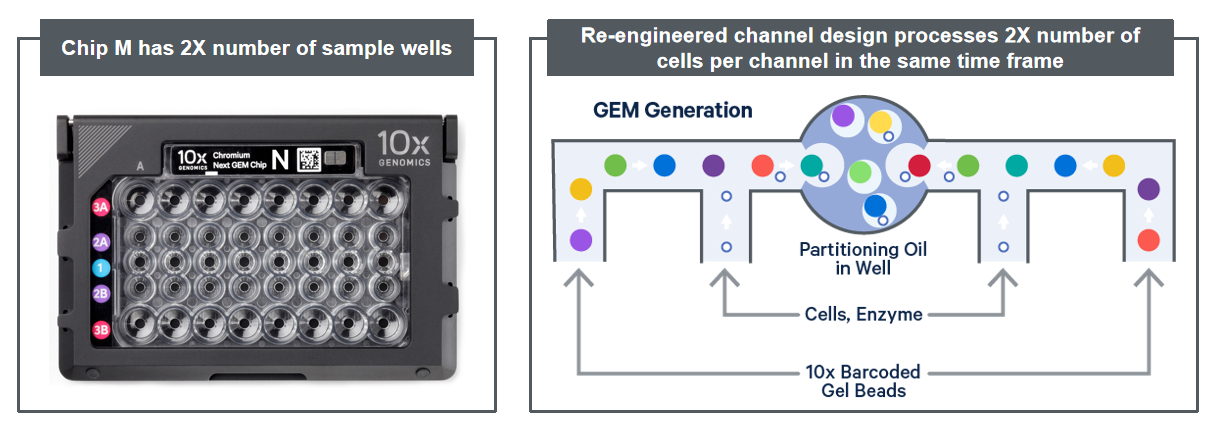
In addition, and in contrast to Illumina data, R2C2 data also allow the determination of cell type-specific and single-cell isoform-level transcriptomes. By merging reads based on the molecular identifiers and demultiplexing reads based on their cellular identifiers, we showed that the R2C2 approach identifies the same cellular identifiers in the cDNA pools and generates comparable single-cell gene expression profiles and cell type clusters as Illumina-based sequencing. To this end, we modified the R2C2 workflow to be compatible with cDNA generated by the 10x Chromium controller and implemented new computational tools to identify 10x molecular and cellular identifiers. We independently analyzed two pools containing the cDNA molecules with a combined ~3000 human peripheral blood mononuclear cells (PBMCs) with Illumina and the established R2C2 (ONT) workflows. In this manuscript, we demonstrate that this combination of high throughput and accuracy of the R2C2 method is sufficient for the Illumina short-read independent analysis of highly multiplexed single-cell cDNA pools generated by the 10x Genomics Chromium controller. This increase in accuracy however comes with a decrease in read throughput as regular cDNA ONT runs can yield from 10 to 20 million reads per MinION flow cell.

We have previously developed and applied the R2C2 approach which uses concatemeric consensus sequencing to improve ONT read accuracy from ~92 to >99% while still producing more than 2 million full-length cDNA sequences per MinION flow cell. Short-read data remain a requirement because either long-read data are not of sufficient depth to cluster cells into cell types or not accurate enough to decode the cellular origin of cDNA molecules.īecause decoding the cellular origin of a cDNA molecule requires accurate sequencing of the molecular identifier, error-prone long read technologies are generally not sufficient to sequence each cDNA pool and to accurately interpret the single-cell data encoded therein. However, for the analysis of high-throughput droplet-based experiments with long reads, short-read data are still required for interpreting experimental data or enabling the identification of cellular and molecular identifiers in low-accuracy ONT reads. These methods have now been used to analyze single-cell cDNA pools generated by different methods, both well- and droplet-based, enriching the information we can extract from single-cell experiments. Instead of sequencing transcript fragments, long-read sequencing methods in the form of Pacific Biosciences (PacBio) and Oxford Nanopore Technologies (ONT) are now capable of sequencing comprehensive full-length transcriptomes. As a result, only a relatively short fragment of the cDNA is then sequenced alongside the cellular identifier limiting the resolution of this approach to the identification of genes associated with a given molecular identifier. The cDNA pools are intended for high-throughput short-read sequencing and must therefore be fragmented such that one read sequence includes the cellular identifier and the sequence of its pair includes a fragment from within the original cDNA molecule. In particular, droplet- or microwell-based methods like Drop-seq, InDrop, 10X Genomics, and Microwell-Seq or Seq-Well single-cell workflows generate pools of full-length cDNA with either the 5′ or 3′ end containing cellular identifiers.

High-throughput single-cell transcriptome analysis however comes with trade-offs. elegans model organisms, to elucidate a new cell type in the lung involved in cystic fibrosis, and to increase our knowledge of adaptive and innate immune cells. Among many other studies, researchers have leveraged the strengths of high-throughput single-cell transcriptome analysis to create single-cell maps of the mouse or C.

Pairing transcriptome analysis with the high-throughput processing of single cells has provided unprecedented insight into cellular heterogeneity. The analysis of transcriptomes using high-throughput sequencers has revolutionized biomedical research.


 0 kommentar(er)
0 kommentar(er)
